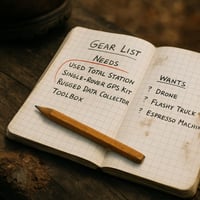Choosing Survey Tech & Equipment Without Busting the Budget
Introduction: Coffee in One Hand, Catalog in the Other
Another tale by Gus the Surveyor...
It all started with a cup of gas station coffee and a glossy gear catalog I’d picked up at the conference center. The kind of morning where your boots are still damp from yesterday, and your inbox is full of client emails asking for updates like you’re a human satellite. I remember flipping through the pages, looking at all the shiny new gadgets: robotic total stations, drones that look like angry hummingbirds, GPS units with more buttons than sense. I sipped my coffee, muttered something about my first prism costing less than this fancy pole bracket, and thought: "Well, Gus, let’s go gadget-shopping."
Survey Tech Ain’t What It Used to Be (And That’s a Good Thing)
Back when I started, if your chain was steel and your transit didn’t wobble, you were living large. We logged bearings in notebooks so grimy you could carbon date them. Now, even the kid fresh outta tech school is walking around with a robotic total station and Bluetooth everything. And you know what? That’s not a bad thing.
I’ve always said, it’s important to stay ahead of the curve—just ahead. You don’t want to be the first poor soul field-testing something fresh outta the lab, but you also don’t want to be the last to hop on the train when it's already left the station. The sweet spot is right before the tech becomes mainstream, when the bugs are worked out but before the price tag jumps and everybody’s using it. That’s where I like to live.
Know Your Job, Know Your Gear
That catalog had me dreaming about all the gear I could buy. But then I remembered a job last year—small boundary retrace in the middle of nowhere. The client was nice, but the pay wasn’t great, and the access road was more goat path than anything else. You think I hauled out my top-end GPS rig? Heck no. I brought my trusty total station and a cooler full of sandwiches. Finished in half a day.
Point is, match your tools to your task. Some jobs do call for cutting-edge tech—I’ve been on projects where having the right drone or a scanner saved me days of work. But not every job needs a $30,000 scanner. Sometimes, all you need is a solid tripod and the willpower to hike a quarter mile with it.
The Gus Method: Three-Tier Gear Strategy
So here’s how I break it down:
-
Tier 1: The Must-Haves. Your bread and butter. Plumb bob, steel tape, reliable tripod, field book that doesn’t fall apart in the rain. These are your daily drivers.
-
Tier 2: The Workhorses. This might be a used total station that’s been babied, or a budget-friendly GPS unit. Not flashy, but dependable. Stuff that earns its keep.
-
Tier 3: The Nice-to-Haves. This is your drone, your LIDAR gear, your robotic total station that talks back. If you can afford it and you’ll use it often, great. But don’t buy it just to look cool at the surveyors’ picnic. And remember: jump in right before the crowd does. That’s when the value’s highest.
Remember: It’s okay to buy used. Some of my favorite gear had a whole other life before it landed in my truck. Just know what to look for.
Bargain Hunting Without Getting Burned
I once bought a tripod from a guy out of his barn. Swore it was "gently used." Turned out it was held together with duct tape and hope. Lesson learned.
If you're buying used, ask for calibration records, pictures, and if possible, a demo. I keep an eye on forums, auction sites, and sometimes even local shops unloading older stock. If it looks too good to be true, it probably is. But there are gems out there, if you’ve got the patience (and a good flashlight).
Stretching Your Budget: Field-Tested Tricks
You don’t have to own everything. I’ve leased GPS units for big projects and borrowed a scanner from a buddy downstate in exchange for some site staking. Keep your gear clean, calibrate it regularly, and treat it like the partner it is. A well-loved instrument can last years longer than the manual says.
Also, if you're running a small outfit, think about teaming up with other crews. Sharing the cost of high-end gear can make a lot of sense if your schedules don't overlap too much.

Conclusion: You Don’t Need the Shiniest Toolbox (But You Need the Right One)
I once did a job alongside a young guy with every fancy gadget you could imagine. Thing is, he spent more time troubleshooting than shooting. Meanwhile, I finished my traverse, packed up, and was halfway through a sandwich by the time he got his drone to stop blinking red.
So here’s the deal: Buy smart, stay slightly ahead of the tech curve, and don’t let your budget (or ego) get pulled into the shiny-tech trap. The best surveyors I know can do more with less, and the smartest ones know when to invest in new tools. The gear? It’s just a means to an end. The real magic's in your brain, your boots, and maybe your coffee mug.
Now if you'll excuse me, there's a just-released data collector online with my name on it—and my coffee's getting cold.




